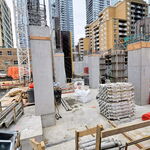Allandale25
Senior Member
Log into Facebook
Log into Facebook to start sharing and connecting with your friends, family, and people you know.
 www.facebook.com
www.facebook.com
 www.facebook.com
www.facebook.com
The reason why you find "a bunch of statistics [...] thrown out" is that I struggle to not read a comparison to VIA's current services out of your initial statement, where you marvel about the upgraded track sections allowing higher speeds between Dresden and Berlin, which you claim to have experienced first-hand and contrast to those you've experienced between Prague and Dresden, while equating the latter with "standard VIA speeds":I am not sure why a bunch of statistics are being thrown out when I was simply illustrating that faster service can be delivered incrementally by upgrading sections of track that will allow trains to run faster on an upgraded ROW. My experience was mentioned to re-enforce my general statement rather than to make a comparison with any other service.
I'm very understanding and sympathetic towards the kind of confirmation bias you seem to have experienced during your trip, but just to establish the scheduled reality in 2015, the scheduled travel time between Prague and Dresden was 2:15h, whereas Dresden to Berlin was 2:08h (note that this is 22 minutes more than the 2018 figure of 1:46h I had previously assumed) and both figures are identical for every single EuroCity (EC) train offered on that line:I have always said, that we can improve track sections to HSR standards so that speeds on those sections can be increased. I experienced that between Dresden and Berlin a few years ago, while the rest of that journey between Prague and Dresden was at standard VIA speeds.
I stand by what I said. As was presented, they are aiming to upgrade track between Dresden and Berlin to 200 km/hr. Obviously, they had not achieved that when I used the service in 2015, however, trains did run on the section of track I was referring to at a speed considerably faster than VIA. This may have not covered even half the distance between Dresden and Berlin at that time, but it was very noticeable. Does VIA provide speed of 160 km/hr in reality on any section of track? Bravo, if they achieve that in the future. Nevertheless, what I was describing was a stepping stone towards 200 km/hr service. HFR is not going to deliver that. Regardless, the route to HSR at 200 km/hr or higher is by upgrading track section by section. This is exactly what was going on between Dresden and Berlin. I don't understand the point of trying to disprove my experience.
VIA's new fleet will be capable of speeds of 200 km/h (125 mph) and large chunks of the HFR Montreal-Ottawa-Toronto route (Vaudreuil-De Beaujeu, Moose Creek-Casselman, Casselman West-Hawthrone Jct., Federal Jct.-Fallowfield and Richmond-Smiths Falls) can be easily upgraded to 200 km/h once the remaining level crossings are grade-separated and as it happens, most of these segments overlap with the E-300 alignment recommended by the Ecotrain Study, which ensures that any investments beyond HFR-standards into these segments remain “future-proof”:Obviously the goal for Dresden-Berlin is higher speed than VIA HFR.

Note: The F-200 alignment is shown in red, whereas the E-300 alignment is shown in blue and a more detailed map can be found in Deliverable 9 (Appendix I) of the Ecotrain Study
Source: Ecotrain Study (Deliverable 5, p.64)
[...]

Note: ROW sections eventually shared with HSR are highlighted in green, whereas existing and new ROW sections which will not be eventually shared with HSR are shown in yellow and red, respectively.
Compiled with: distances obtained from historic CN/CP timetables or measured with Google Earth and routings obtained from The Globe And Mail (for HFR) and the Ecotrain Study (Deliverable 5).
The goal for Montreal-Toronto should be 3hr 59min with HFR. Now, how to achieve that? I have commented before about using the Winchester sub for express trains, which will bypass Ottawa. Since that would be almost 100% rural and straight, is it feasible and cost effective?
Maybe I'm just again misunderstanding the argument you are trying to make, but for someone who believes in incremental upgrades with every step representing tangible benefits at a politically digestible taxpayer cost, you seem to be surprisingly insistent that HFR should have a travel time between Montreal and Toronto of under 4 hours from day one and even if this would mean increasing the total length of the HFR (and thus the length of railway corridors which require upgrades) between Montreal and Toronto by 150 km (or one quarter: 150/580=25.9%), just for saving a few Express trains per day a mere 34 km (or 5.9%) compared to a Montreal-Ottawa-Toronto run, which would represent a time saving of only 17 minutes (again: 5.9%) if we assume that average speed remains the same. And all of that with the dubious benefit of bypassing this nation's capital and 3rd-largest CMA...Also, I have spoken of using the Winchester sub east of Smiths Falls for Montreal express trains. Who says we can't upgrade that section of track to HSR standards right away? It is a great opportunity given how straight that track is and could further speed up service to Montreal.
If you really don't grasp the difference between 17 (it's 16, by the way: 10 to Ottawa and 6 to Montreal) departures offered between Toronto and either Montreal or Ottawa and a comparable number of departures offered to both cities simultaneously, then this would be at least an explanation for why you struggle so much to fully understand the benefits of HFR...I will also like to point out that there is something like 17 departures today from Toronto to Montreal and Ottawa. Going to 18 departures with HFR in a way is underwhelming.
nation's capital and 3rd-largest CMA
It was the fifth-largest CMA in 2016 (down from #4 in 2011), but I was indeed guilty of forgetting about Western Canada (in this case: Vancouver [and I've been there as little as 3 months ago, sorry @ssiguy2Small quibble. Isn't Ottawa the sixth largest CMA?
Thank you very much and glad to know they find an interested and satisfied readership...As usual the rest of your points are spot on.
It's going to be late and overbudget with Accenture running Presto.
As long as Transport Canada insists on "intercity rail" services not selling more tickets than seats, I don't see how you could simply tap to start a paid journey, as you would need to select which train you are tapping on for. Also, I don't know what the maximum limits for transactions and balances are for the Presto card, whereas the OPUS card doesn't even seem to have any money functions (you can only save tickets). Maybe you could save your commuter or bizpaks on such a card, but I see very limited use unless the obligation to reserve in advance becomes abolished. That said, maybe you can think of potential uses of these cards for VIA passengers.
The reason why you find "a bunch of statistics [...] thrown out" is that I struggle to not read a comparison to VIA's current services out of your initial statement, where you marvel about the upgraded track sections allowing higher speeds between Dresden and Berlin, which you claim to have experienced first-hand and contrast to those you've experienced between Prague and Dresden, while equating the latter with "standard VIA speeds":
I'm very understanding and sympathetic towards the kind of confirmation bias you seem to have experienced during your trip, but just to establish the scheduled reality in 2015, the scheduled travel time between Prague and Dresden was 2:15h, whereas Dresden to Berlin was 2:08h (note that this is 22 minutes more than the 2018 figure of 1:46h I had previously assumed) and both figures are identical for every single EuroCity (EC) train offered on that line:
View attachment 195550
Source: Fernbahn.de timetable archive
As I said above, I find it very understandable that you subconsciously sought for confirmation of your expectation that a noticeably better level of infrastructure maintenance must lead to a higher maximum and average speed than what you were used to from VIA services in the Montreal-Ottawa-Toronto triangle, but in reality, the average scheduled speed you experienced between Dresden and Berlin was identical to that of the average Montreal-Ottawa train. Nevertheless, your expectations would have been confirmed by reality had you continued your journey in the EC train to Hamburg (and even more so, if you had done that journey in one of the ICE trains), as that line has already been upgraded to speeds of 230 km/h:
View attachment 195553
Source: Fernbahn.de timetable archive (for Berlin-Dresden), official VIA Rail timetable (effective 2019-06-02) and official VIA Rail presentation (for HFR)
Therefore, maybe we can agree that you made the right observations (that incremental upgrades of legacy rail lines may allow speeds in excess of what VIA offers today on the Corridor and even of what it promises with HFR), even though you happened to make them on the wrong line?
VIA's new fleet will be capable of speeds of 200 km/h (125 mph) and large chunks of the HFR Montreal-Ottawa-Toronto route (Vaudreuil-De Beaujeu, Moose Creek-Casselman, Casselman West-Hawthrone Jct., Federal Jct.-Fallowfield and Richmond-Smiths Falls) can be easily upgraded to 200 km/h once the remaining level crossings are grade-separated and as it happens, most of these segments overlap with the E-300 alignment recommended by the Ecotrain Study, which ensures that any investments beyond HFR-standards into these segments remain “future-proof”:
Maybe I'm just again misunderstanding the argument you are trying to make, but for someone who believes in incremental upgrades with every step representing tangible benefits at a politically digestible taxpayer cost, you seem to be surprisingly insistent that HFR should have a travel time between Montreal and Toronto of under 4 hours from day one and even if this would mean increasing the total length of the HFR (and thus the length of railway corridors which require upgrades) between Montreal and Toronto by 150 km (or one quarter: 150/580=25.9%), just for saving a few Express trains per day a mere 34 km (or 5.9%) compared to a Montreal-Ottawa-Toronto run, which would represent a time saving of only 17 minutes (again: 5.9%) if we assume that average speed remains the same. And all of that with the dubious benefit of bypassing this nation's capital and 3rd-largest CMA...
If you really don't grasp the difference between 17 (it's 16, by the way: 10 to Ottawa and 6 to Montreal) departures offered between Toronto and either Montreal or Ottawa and a comparable number of departures offered to both cities simultaneously, then this would be at least an explanation for why you struggle so much to fully understand the benefits of HFR...
Not sure where to post this, but anyone know what happened to steveintoronto? He used to post constantly on these forums and has been silent for a while.
Might have gotten locked out of his account, steve and I have been having issues with the website redesign. https://urbantoronto.ca/forum/threads/urbantoronto-redesign.26104/page-6He commented on Munro's blog today so he's still around in the ether somewhere...
Might have gotten locked out of his account, steve and I have been having issues with the website redesign. https://urbantoronto.ca/forum/threads/urbantoronto-redesign.26104/page-6
Not sure if I am meant to share this but one of the mods advised me that Steve was permanently banned after repeated warnings. IMHO the blustering personal attacks were getting tiresome but it's always good to hear that someone in the UT community is ok at least.
Don't count reliable arrival times. I took the Canadian from Vancouver to Winnipeg at the start of May. We had to stop repeatedly for freight trains along the route. Our arrival time in Winnipeg was around 10 pm. The train actually arrived at 5 am. Be prepared!! Nevertheless, the Canadian is an experience. I loved the journey, meeting people, the views, and the food is excellent.We are taking the ViA Canadian to Edmonton next week and are interested in knowing if the recent schedule changes have made it more reliable. Any ideas of a site that reports 'historic' arrival times?
Found it! https://asm.transitdocs.com/
and https://asm.transitdocs.com/map
Given that you already boasted how "much more readable [this thread becomes] without his posts" more than three years ago, I somehow doubt that you are in the best place to comment about his posts since then. Also, just like I told you back then that it violated my sense of fairness to urge other users to block somebody, the same judgement applies to talking about someone who you know that he has no longer the power to reply. You are right, that he - together with quite a few other users - was reliably near the centre of most overheating arguments, but he was just as reliably among those who were sent on increasingly longer vacations from this forum.Not to get too far off-topic, but good riddance. Over a decade in this community and he was the only member that I ever blocked. And I have some very heated debates with lots of different folks in these parts.
He doesn't seem as interested in discourse as he was in being argumentative and "winning" the argument. And he seemed to think spamming every thread with walls of links or copy-and-paste articles (some of which probably violated fair use clauses) was some great contribution that he let him talk down to others or shout down people.
I am sure he'll be back though. Just watch for the next account with a wall of links and constant argumentative tone. He can't help himself.




